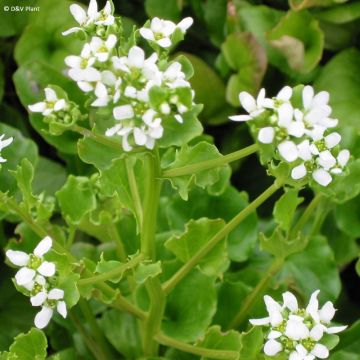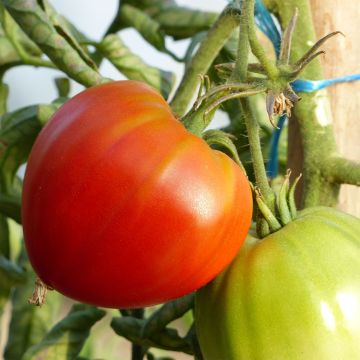

Salvia officinalis Growers Friend


Salvia officinalis Growers Friend
Salvia officinalis Growers Friend
Salvia officinalis Grower's Friend
Common Sage, Garden Sage, Culinary Sage, Broadleaf Sage
The 3 young plants are beautiful. They were well packaged and the habit was very fast.
Christiane, 24/05/2023
Special offer!
Receive a €20 voucher for any order over €90 (excluding delivery costs, credit notes, and plastic-free options)!
1- Add your favorite plants to your cart.
2- Once you have reached €90, confirm your order (you can even choose the delivery date!).
3- As soon as your order is shipped, you will receive an email containing your voucher code, valid for 3 months (90 days).
Your voucher is unique and can only be used once, for any order with a minimum value of €20, excluding delivery costs.
Can be combined with other current offers, non-divisible and non-refundable.
Home or relay delivery (depending on size and destination)
Schedule delivery date,
and select date in basket
This plant carries a 6 months recovery warranty
More information
We guarantee the quality of our plants for a full growing cycle, and will replace at our expense any plant that fails to recover under normal climatic and planting conditions.
Description
Salvia officinalis 'Grower's Friend' is a highly fragrant variety with green leaves and red stems. It is a very hardy perennial plant, both aromatic and decorative. Easy to grow, this plant with medicinal properties can be grown in pots or in the ground. Its intensely fragrant leaves add flavour to fish, poultry, sauces, and vegetables. The plug plants of this variety are produced organically and should be planted in spring. Harvesting can be done from March to October.
Sage has been widely present since the Middle Ages. This perennial plant has a bushy habit and grows to a height of 40 to 60cm (16 to 24in). Its oval, grey-green leaves are highly fragrant. It is a very hardy plant, tolerating temperatures as low as -15°C (5°F), and can be grown in both vegetable gardens and ornamental gardens. It produces spike-like inflorescences in summer, often with a bluish-purple colour that can vary depending on the variety. Common sage belongs to the Lamiaceae family, just like thyme.
The saying “he who has sage in his garden needs no doctor” demonstrates the medicinal properties of common sage. It is also known as the “saving plant”. Sage is known for its diuretic, tonic, antiseptic, antiperspirant, and antispasmodic properties.
In cooking, fresh or dried leaves add flavour to fish, poultry, sauces, and vegetables. Add the leaves at the end of cooking to preserve their aroma. They can also be used in infusions.
Harvesting: The leaves can be harvested from March to October, ideally in the morning, by cutting the branches. Regular harvesting will promote the growth of new shoots. The fragrance will be more intense in spring, just before flowering.
Storage: Fresh sage leaves can be stored in the refrigerator for a few days. For longer storage, you can dry the branches in the shade and keep the leaves in airtight jars for several months.
Gardening tip: In the garden, mix different types of plants by placing sage in the middle of perennial flower beds or even in rock gardens. It will blend in perfectly. The strong scents of aromatic plants can often repel insects that may attack more delicate plants like certain roses.
Report an error about the product description
Harvest
Plant habit
Foliage
Other Vegetable plants A to Z
View all →Planting and care
Sage appreciates light, well-drained, rich, rather dry and slightly alkaline soils. Plant it in full sun.
Plug plants should be planted in spring, from February to May.
In the ground: First, let the plug plants grow by transplanting them into trays or pots with a diameter of 8 to 13cm (3 to 5in), filled with compost. Place them in a warm and bright location. Water regularly.
When planting in the ground, space the plants 40cm (16in) apart in rows and 80cm (32in) between rows. Dig a hole, place the root ball and cover with fine soil. Firmly tamp down and water. Hoe and weed regularly, especially at the beginning of cultivation.
Add well-rotted compost every year. Use mulch to protect from cold.
In a pot: Place a layer of gravel or clay pebbles at the bottom of the pot to facilitate drainage. Fill the pot with a mixture of compost, garden soil, and sand. Carefully place the plug plant, cover with soil and firm down. Water. Place the pot in the sun and bring it indoors in case of frost.
During cultivation, water moderately as sage is sensitive to excess moisture.
You can propagate sage by dividing the clumps in spring, thus allowing the plants to regenerate and be placed in another location in the garden. This operation is recommended every 5 years or so.
Cultivation
Care
Intended location
-
, onOrder confirmed
Reply from on Promesse de fleurs
Similar products
Haven't found what you were looking for?
Hardiness is the lowest winter temperature a plant can endure without suffering serious damage or even dying. However, hardiness is affected by location (a sheltered area, such as a patio), protection (winter cover) and soil type (hardiness is improved by well-drained soil).

Photo Sharing Terms & Conditions
In order to encourage gardeners to interact and share their experiences, Promesse de fleurs offers various media enabling content to be uploaded onto its Site - in particular via the ‘Photo sharing’ module.
The User agrees to refrain from:
- Posting any content that is illegal, prejudicial, insulting, racist, inciteful to hatred, revisionist, contrary to public decency, that infringes on privacy or on the privacy rights of third parties, in particular the publicity rights of persons and goods, intellectual property rights, or the right to privacy.
- Submitting content on behalf of a third party;
- Impersonate the identity of a third party and/or publish any personal information about a third party;
In general, the User undertakes to refrain from any unethical behaviour.
All Content (in particular text, comments, files, images, photos, videos, creative works, etc.), which may be subject to property or intellectual property rights, image or other private rights, shall remain the property of the User, subject to the limited rights granted by the terms of the licence granted by Promesse de fleurs as stated below. Users are at liberty to publish or not to publish such Content on the Site, notably via the ‘Photo Sharing’ facility, and accept that this Content shall be made public and freely accessible, notably on the Internet.
Users further acknowledge, undertake to have ,and guarantee that they hold all necessary rights and permissions to publish such material on the Site, in particular with regard to the legislation in force pertaining to any privacy, property, intellectual property, image, or contractual rights, or rights of any other nature. By publishing such Content on the Site, Users acknowledge accepting full liability as publishers of the Content within the meaning of the law, and grant Promesse de fleurs, free of charge, an inclusive, worldwide licence for the said Content for the entire duration of its publication, including all reproduction, representation, up/downloading, displaying, performing, transmission, and storage rights.
Users also grant permission for their name to be linked to the Content and accept that this link may not always be made available.
By engaging in posting material, Users consent to their Content becoming automatically accessible on the Internet, in particular on other sites and/or blogs and/or web pages of the Promesse de fleurs site, including in particular social pages and the Promesse de fleurs catalogue.
Users may secure the removal of entrusted content free of charge by issuing a simple request via our contact form.
The flowering period indicated on our website applies to countries and regions located in USDA zone 8 (France, the United Kingdom, Ireland, the Netherlands, etc.)
It will vary according to where you live:
- In zones 9 to 10 (Italy, Spain, Greece, etc.), flowering will occur about 2 to 4 weeks earlier.
- In zones 6 to 7 (Germany, Poland, Slovenia, and lower mountainous regions), flowering will be delayed by 2 to 3 weeks.
- In zone 5 (Central Europe, Scandinavia), blooming will be delayed by 3 to 5 weeks.
In temperate climates, pruning of spring-flowering shrubs (forsythia, spireas, etc.) should be done just after flowering.
Pruning of summer-flowering shrubs (Indian Lilac, Perovskia, etc.) can be done in winter or spring.
In cold regions as well as with frost-sensitive plants, avoid pruning too early when severe frosts may still occur.
The planting period indicated on our website applies to countries and regions located in USDA zone 8 (France, United Kingdom, Ireland, Netherlands).
It will vary according to where you live:
- In Mediterranean zones (Marseille, Madrid, Milan, etc.), autumn and winter are the best planting periods.
- In continental zones (Strasbourg, Munich, Vienna, etc.), delay planting by 2 to 3 weeks in spring and bring it forward by 2 to 4 weeks in autumn.
- In mountainous regions (the Alps, Pyrenees, Carpathians, etc.), it is best to plant in late spring (May-June) or late summer (August-September).
The harvesting period indicated on our website applies to countries and regions in USDA zone 8 (France, England, Ireland, the Netherlands).
In colder areas (Scandinavia, Poland, Austria...) fruit and vegetable harvests are likely to be delayed by 3-4 weeks.
In warmer areas (Italy, Spain, Greece, etc.), harvesting will probably take place earlier, depending on weather conditions.
The sowing periods indicated on our website apply to countries and regions within USDA Zone 8 (France, UK, Ireland, Netherlands).
In colder areas (Scandinavia, Poland, Austria...), delay any outdoor sowing by 3-4 weeks, or sow under glass.
In warmer climes (Italy, Spain, Greece, etc.), bring outdoor sowing forward by a few weeks.



















































